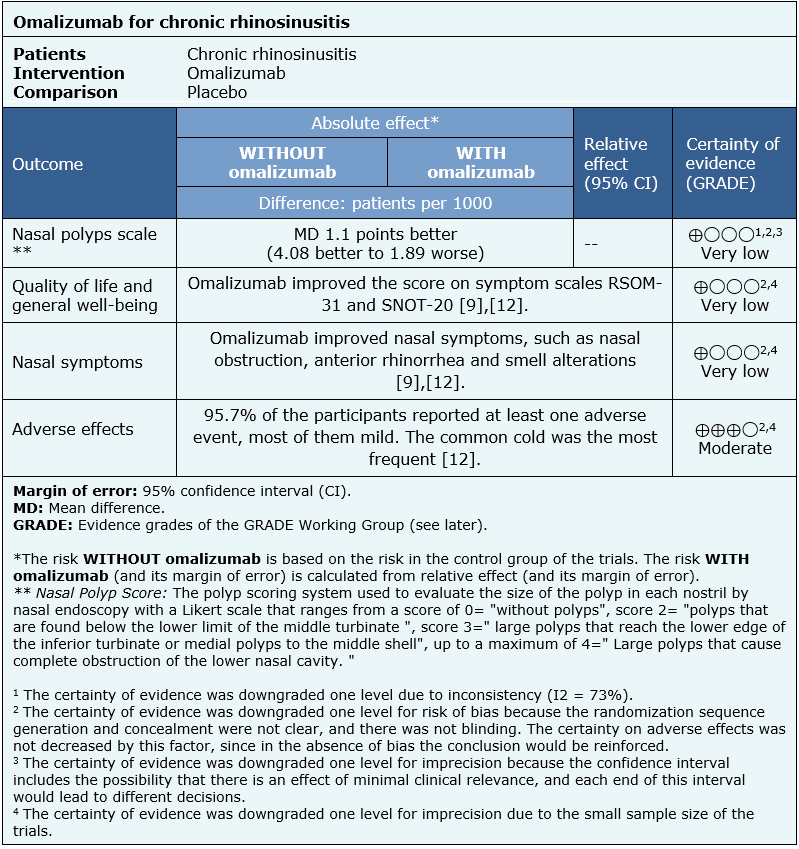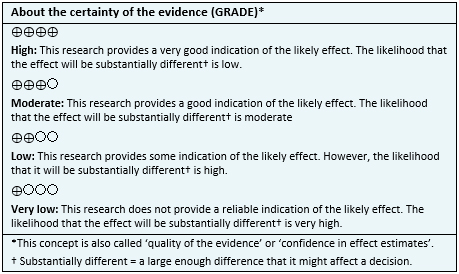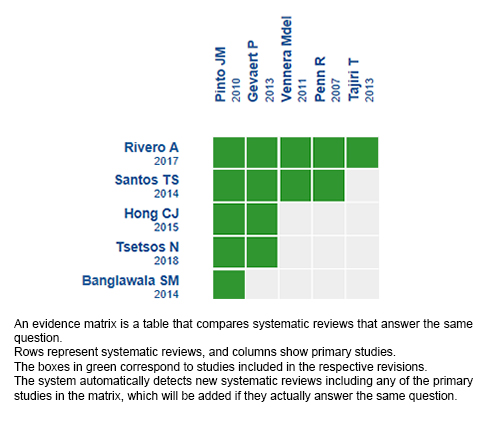Resúmenes Epistemonikos
← vista completaPublicado el 23 de noviembre de 2018 | http://doi.org/10.5867/medwave.2018.07.7346
Omalizumab para la rinosinusitis crónica
Omalizumab for chronic rhinosinusitis
Abstract
INTRODUCTION Chronic rhinosinusitis is a high prevalence chronic inflammatory disease that involves nasal mucosa and paranasal sinuses. Immunoglobulin E is an inflammatory mediator that plays an etiopathogenic role in this condition, so omalizumab, an anti-immunoglobulin E monoclonal antibody, might be a therapeutic alternative.
METHODS We searched in Epistemonikos, the largest database of systematic reviews in health, which is maintained by screening multiple information sources, including MEDLINE, EMBASE, Cochrane, among others. We extracted data from the systematic reviews, reanalyzed data of primary studies, conducted a meta-analysis and generated a summary of findings table using the GRADE approach.
RESULTS AND CONCLUSIONS We identified five systematic reviews that included five primary studies overall, of which two correspond to randomized trials. We concluded it is not clear whether omalizumab leads to an improvement in the nasal polyps scale, quality of life, general well-being or nasal symptoms in patients with chronic rhinosinusitis, because the certainty of the evidence is very low. On the other hand, omalizumab is probably associated with frequent adverse effects.
Problem
Chronic rhinosinusitis is an inflammatory disease of the mucosa of the nasal cavity and paranasal sinuses lasting longer than 12 weeks. It is a common disease that could affect more than 15% of the total population in the United States [1], which is why it is an important health problem that affects quality of life. Although there are therapeutic alternatives, a group of patients remains symptomatic. It has been suggested that this may be due to most treatments focusing on relief of symptoms and reduction of inflammation, rather than in the cause. Current research has changed the approach to target barrier responses and states of chronic inflammation [2].
Omalizumab is a humanized monoclonal antibody that selectively binds to the crystallizable fragment (Fc) region of immunoglobulin E (IgE) by reducing free immunoglobulin E, which produces an anti-inflammatory effect and apoptosis of eosinophils. However, it is not clear to what extent this is translated into a clinical effect.
Methods
We searched in Epistemonikos, the largest database of systematic reviews in health, which is maintained by screening multiple information sources, including MEDLINE, EMBASE, Cochrane, among others, to identify systematic reviews and their included primary studies. We extracted data from the identified reviews and reanalyzed data from primary studies included in those reviews. With this information, we generated a structured summary denominated FRISBEE (Friendly Summary of Body of Evidence using Epistemonikos) using a pre-established format, which includes key messages, a summary of the body of evidence (presented as an evidence matrix in Epistemonikos), meta-analysis of the total of studies when it is possible, a summary of findings table following the GRADE approach and a table of other considerations for decision-making.
|
Key messages
|
About the body of evidence for this question
|
What is the evidence. |
We found five systematic reviews [3],[4],[5],[6],[7],[8] that included five primary studies [9],[10],[11],[12],[13] of which two correspond to randomized controlled trials [9],[12]. This table and the summary in general are based on the two randomized trials [9],[12], given the observational studies did not increase the certainty of the existing evidence or provide relevant additional information. |
|
What types of patients were included* |
Both trials included patients older than 18 years [9],[12]. One trial evaluated patients suffering from chronic rhinosinusitis with nasal polyps and asthma for more than 2 years [12], and the other trial evaluated patients after sinus surgery [9]. |
|
What types of interventions were included* |
All trials used omalizumab as an intervention. One trial administered omalizumab 150-375 mg every 2 weeks [12] and another 0,016 mg/kg once a month [9]. Both trials compared the intervention against placebo. |
|
What types of outcomes |
The trials evaluated multiple outcomes, which were grouped by the systematic reviews as follows:
The average follow-up was 12.9 months, with a range between 5 and 28 months. |
* The information about primary studies is extracted from the systematic reviews identified, unless otherwise specified.
Summary of findings
The information on the effects of omalizumab in chronic rhinosinusitis is based on two randomized trials that included 38 patients [9],[12].
Both trials reported the effect on the Nasal Polyp Score (31 patients), changes in quality of life (38 patients) and nasal symptoms (38 patients) [9],[12]. Only one trial reported adverse effects (24 patients) [12].
The summary of findings is as follows:
- It is not clear whether omalizumab leads to an improvement in the Nasal Polyps Score in chronic rhinosinusitis because the certainty of the evidence is very low.
- It is not clear whether omalizumab leads to an improvement in quality of life and general well-being because the certainty of the evidence is very low.
- It is not clear whether omalizumab leads to an improvement in nasal symptoms (nasal obstruction, loss of sense of smell and presence of rhinorrhea) because the certainty of the evidence is very low.
- Omalizumab probably has adverse effects in patients with chronic rhinosinusitis. The certainty of the evidence is moderate.

| Follow the link to access the interactive version of this table (Interactive Summary of Findings – iSoF) |

Other considerations for decision-making
|
To whom this evidence does and does not apply |
|
| About the outcomes included in this summary |
|
| Balance between benefits and risks, and certainty of the evidence |
|
| Resource considerations |
|
| What would patients and their doctors think about this intervention |
|
|
Differences between this summary and other sources |
|
| Could this evidence change in the future? |
|
How we conducted this summary
Using automated and collaborative means, we compiled all the relevant evidence for the question of interest and we present it as a matrix of evidence.

Follow the link to access the interactive version: Omalizumab for chronic rhinosinusitis.
Notes
The upper portion of the matrix of evidence will display a warning of “new evidence” if new systematic reviews are published after the publication of this summary. Even though the project considers the periodical update of these summaries, users are invited to comment in Medwave or to contact the authors through email if they find new evidence and the summary should be updated earlier.
After creating an account in Epistemonikos, users will be able to save the matrixes and to receive automated notifications any time new evidence potentially relevant for the question appears.
This article is part of the Epistemonikos Evidence Synthesis project. It is elaborated with a pre-established methodology, following rigorous methodological standards and internal peer review process. Each of these articles corresponds to a summary, denominated FRISBEE (Friendly Summary of Body of Evidence using Epistemonikos), whose main objective is to synthesize the body of evidence for a specific question, with a friendly format to clinical professionals. Its main resources are based on the evidence matrix of Epistemonikos and analysis of results using GRADE methodology. Further details of the methods for developing this FRISBEE are described here (http://dx.doi.org/10.5867/medwave.2014.06.5997)
Epistemonikos foundation is a non-for-profit organization aiming to bring information closer to health decision-makers with technology. Its main development is Epistemonikos database (www.epistemonikos.org).
Potential conflicts of interest
The authors do not have relevant interests to declare.

